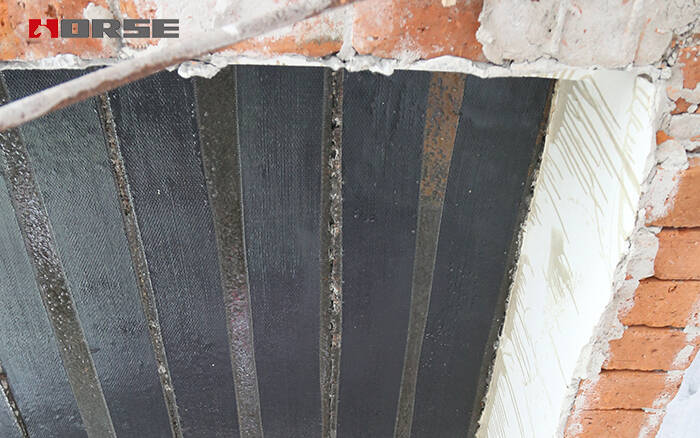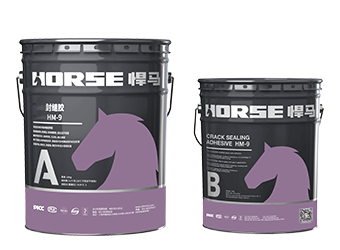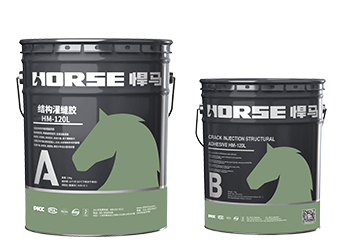Solutions
Horse Construction offers full range of structural strengthening materials with technical supports, documentation supports, products supports, project supports.
How To Identify And Analyze The Cracks Of Concrete Components
Cracks in common components
01 Cracks in the brick wall

1. The "eight"-shaped crack
Mainly appear at both ends of the horizontal wall and the vertical wall. A kind of cracks belonging to the uneven settlement of the foundation. When the settlement at both ends of the house is small and the settlement in the middle is large, reverse bending deformation is formed, and diagonal cracks appear on the longitudinal wall. Most of the cracks pass through the two diagonal corners of the window and are distributed in a "eight" shape on the wall.
Another type of crack is a temperature shrinkage crack, which is generally located at both ends of the top floor of a house. Sometimes it may develop to 1/3 of the length of the house, and in severe cases, it may develop to 1 to 2 floors below the top floor. The main reason for the formation of this crack is that after the temperature rises, the temperature deformation of the roof slab is greater than that of the masonry, resulting in a certain temperature stress. The force of the roof slab is transmitted to the wall, so that the top wall is subjected to tensile and shear forces. The tensile stress and shear stress are large at both ends and small in the middle. When the tensile stress exceeds the tensile limit of the masonry, the walls at both ends will appear "eight"-shaped cracks.
2. Inverted "eight" shaped crack
When the settlement at both ends of the house is large and the settlement in the middle is small, reverse bending deformation is formed, and diagonal cracks appear on the longitudinal wall. Most of the cracks pass through the two opposite corners of the window and are distributed in an inverted "eight" shape on the wall.
3. horizontal cracks
It is mostly located at the top and horizontal walls, parapets and gables. When the roof thermal insulation is poor, the roof panel is heated and expands, which produces a horizontal force on the wall, and the wall shrinks more than the middle at the end and the shear resistance of the masonry is low, causing horizontal cracks between the wall and the roof panel. In addition, when the house has local uneven settlement, the wall in the lower crack area in the middle has its own weight, which causes vertical tensile stress and causes horizontal cracks in the wall.
Four, vertical cracks
Mainly appear at the window sill wall, the end of the lintel and the staggered floor. The reason for the cracks is that when the temperature difference between the air temperature and the ambient temperature is too large, the deformation difference between the brick masonry and the concrete member increases. And they are mutually restrained, so a large tensile stress is generated on the wall, and the wall is cracked. Vertical cracks generally only occur locally in the wall, the bottom layer is more serious than the upper layer, and the cracks are wider near the floor.
Five, X-shaped crack
Most of the cracks along the mortar joints of the masonry are mainly formed by the repeated action of thermal expansion and contraction of the house, while the X-shaped cracks produced in the bottom wall are caused by uneven foundation or uneven settlement.
02 Cracks in concrete columns
The stress cracks of the column are different according to the different stress modes.
1. Axial compression
When the axial pressure exceeds the bearing capacity of the column, vertical discontinuous cracks appear on all four sides of the column.
2. Large eccentric compression
Horizontal cracks first appeared on the side of the column far away from the longitudinal force, and then multiple vertical discontinuous cracks appeared on the side of the column near the longitudinal force.
Three, small eccentric compression
Multiple vertical discontinuous cracks appeared on the side of the column close to the longitudinal force.
The deformation cracks (unstressed cracks) of the column are mostly caused by uneven foundation settlement or premature mold removal, and horizontal circular cracks appear at the upper and lower ends of the column and other construction joints. The X-shaped cracks of the column are mostly shear cracks under the action of earthquake.
03 Cracks in concrete beams
The stress cracks appearing at the bottom of the beam's mid-span, the cracks are perpendicular to the beam, the bottom is wide and the top is narrow, and it gradually tilts from the mid-span to the sides, which is caused by a positive bending moment. The stress cracks appearing at the top of the support edge of the beam are wide at the top and narrow at the bottom, which are caused by the negative bending moment of the support. The stress cracks appearing outside the edge of the support at the bottom of the beam are 45° oblique and are caused by bending moments and shear forces.
Unstressed cracks of beams generally occur on both sides of the beam. The cracks are linear, roughly equidistant, parallel to the stirrups, and the cracks are wide at the top and narrow at the bottom. Most of them are caused by the impact of concrete shrinkage and temperature difference.
04 Cracks in cast-in-place concrete slab
Cast-in-place concrete unidirectional slab: stress cracks may appear at the bottom span of the slab, parallel to the long side of the slab, and the tensile stress generated by the mid-span positive bending moment of the tie slab at the bottom of the slab exceeds the tensile strength of the concrete. It may also occur when the board surface is located at the edge of the secondary beam and is caused by the negative bending moment of the support of the board.
Cast-in-situ concrete two-way slab: stress cracks first appear in the middle of the bottom of the slab and parallel to the long sides, and then gradually extend to the four corners of the slab along a 45° diagonal line, which is related to the trapezoidal distribution of the surface load of the slab. The four corners of the cast-in-place concrete slab often appear 45° cut corner cracks. After the slab is under load, there will be deflection in the middle, and the four corners have a tendency to lift. However, due to the constraints of walls or beams, negative bending moments are generated, and 45° diagonal cracks almost perpendicular to the diagonal are generated.
Many of the deformation cracks of cast-in-place reinforced concrete beams are penetrating cracks. The shape of the slab surface and the slab bottom are roughly the same, and the positions of the slab surface and the slab bottom are roughly similar but not completely consistent. When the shrinkage of the plate is greater than that of the beam, it will inevitably cause the tensile stress in the plate, and the compressive stress in the beam, that is, the beam restrains the shrinkage of the plate, and it is easy to cause the plate to crack. The shrinkage crack direction of cast-in-situ reinforced concrete slab depends on the restraint and tensile capacity, so the crack direction is generally perpendicular to the direction of greater restraint and the direction of weaker tensile ability, that is, perpendicular to the long side and parallel to the short side.
Crack analysis
01 Determine whether it is a structural crack or a non-structural crack
Structural cracks are mostly caused by structural stress reaching the limit, resulting in insufficient bearing capacity. It is a characteristic of the beginning of structural failure or a sign of insufficient structural strength. Further analysis of the cracks is necessary. According to the nature of the force and the form of failure, it is divided into brittle failure and plastic failure. The characteristic of brittle failure is that it happens suddenly without obvious warning in advance. Once cracks appear, it will have a great impact on the strength of the structure and reinforcement measures must be taken. The characteristic of plastic failure is that there are obvious signs of deformation and cracks in advance, which can be remedied by measures, and the risk is relatively small.
Non-structural cracks are often formed by their own stress, such as temperature cracks and shrinkage cracks, which have little effect on the bearing capacity of the structure. Repair measures can be taken according to the requirements of structural durability, impermeability, earthquake resistance, and use.
02 Find out the width, length, depth, shape and other data of the crack
When the crack exceeds the limit value of the specification, it will seriously affect the integrity of the component. The reason should be found out, and the necessary reinforcement measures should be taken according to the danger.
03 Determine whether the crack is stable and its development trend
As long as the stability crack does not exceed the allowable value of the specification, it is generally considered safe. Active cracks should be judged to be larger or smaller according to use and changes, so as to determine whether to strengthen. The development of cracks is often caused by the increase of the load, which causes the bearing capacity of the component to reach the limit state. It is more dangerous and must be reinforced.

Common crack treatment methods
There are 6 common treatment methods for concrete cracks: grouting method, structural reinforcement method, surface treatment method, filling method, and electrochemical protection method.
To solve the problem of concrete cracks, we need to start with the causes of concrete cracks, correctly judge the causes and development of cracks in different parts, and also consider the bearing capacity of structural members, the nature of the house, the environment in which the house is located, the history of the house, and many other factors. Therefore, a reasonable plan for reinforcement treatment can be selected to effectively solve the hidden safety hazards caused by concrete cracks.
You can find anything here you are in need of, have a trust trying on these products, you will find the big difference after that.

High strength crack sealing repairing adhesive for the fracture surface of concrete crack

Very strong penetration and low viscosity epoxy crack injection adhesive for repairing concrete crack

High strength, unidirectional carbon fiber sheet pre-saturated to form a carbon fiber reinforced polymer (CFRP) sheet used to strengthen structural concrete elements.